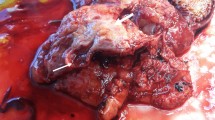Abstract
Pancreatic undifferentiated carcinoma with osteoclast-like giant cells (UC-OGC) is an extremely rare and aggressive malignancy. We report the case of a 71-year-old male who presented with a solid-and-cystic mass in the pancreatic head. The cut section of the pancreaticoduodenectomy specimen showed hemorrhagic polypoid lesions localized to the cyst spaces. Histological examination revealed a cystic background as an intraductal papillary mucinous neoplasm (IPMN) with low-grade dysplasia, while the intra-cystic polypoid mass was morphologically identical to giant cell tumors (GCT) of bone and soft tissue, consisting of a mixture of mononuclear histiocyte-like cells and multinucleated osteoclast-like giant cells. Nuclei of the mononuclear cells were similar to those of the multinucleated giant cells, showing no obvious atypia. The mononuclear cells were diffusely immunoreactive for CD163 and completely negative for all examined epithelial markers. Genetic analysis showed both the IPMN and the GCT-like components harbored identical double mutations of KRAS (G12V) and GNAS (R201C), and confirmed a diagnosis of UC-OGC originating from IPMN. This case emphasized that pancreatic UC-OGC can provide bland morphology, which is morphologically and immunohistochemically undistinguishable from GCT of the bone and soft tissue. Our study also highlights the importance of genetic analyses in properly diagnosing and managing such patients.


Similar content being viewed by others
References
Wieneke JA, Gannon FH, Heffner DK, et al. Giant cell tumor of the larynx: a clinicopathologic series of eight cases and a review of the literature. Mod Pathol. 2001;14:1209–15.
Fu K, Moran CA, Suster S. Primary mediastinal giant cell tumors: a clinicopathologic and immunohistochemical study of two cases. Ann Diagn Pathol. 2002;6:100–5.
Fukushima N, Hruban RH, Kato Y, et al. Ductal adenocarcinoma variants and mixed neoplasms of the pancreas. In: Bosman FT, Carneiro F, Hruban RH, et al., editors. WHO classification of tumours of the digestive system. 4th ed. Lyon: IARC Press; 2010. p. 292–5.
Muraki T, Reid MD, Basturk O, et al. Undifferentiated carcinoma with osteoclastic giant cells of the pancreas: clinicopathologic analysis of 38 cases highlights a more protracted clinical course than currently appreciated. Am J Surg Pathol. 2016;40:1203–16.
Hosoda W, Sasaki E, Murakami Y, et al. GNAS mutation is a frequent event in pancreatic intraductal papillary mucinous neoplasms and associated adenocarcinomas. Virch Arch. 2015;466:665–74.
Rosai J. Carcinoma of pancreas simulating giant cell tumor of bone. Electron-microscopic evidence of its acinar cell origin. Cancer. 1968;22:333–44.
Trepeta RW, Mathur B, Lagin S, et al. Giant cell tumor (“osteoclastoma”) of the pancreas: a tumor of epithelial origin. Cancer. 1981;48:2022–8.
Lewandrowski KB, Weston L, Dickersin GR, et al. Giant cell tumor of the pancreas of mixed osteoclastic and pleomorphic cell type: evidence for a histogenetic relationship and mesenchymal differentiation. Hum Pathol. 1990;21:1184–7.
Luchini C, Pea A, Lionheart G, et al. Pancreatic undifferentiated carcinoma with osteoclast-like giant cells is genetically similar to, but clinically distinct from, conventional ductal adenocarcinoma. J Pathol. 2017;243:148–54.
Lukás Z, Dvorák K, Kroupová I, et al. Immunohistochemical and genetic analysis of osteoclastic giant cell tumor of the pancreas. Pancreas. 2006;32:325–9.
Lau SK, Chu PG, Weiss LM. CD163: a specific marker of macrophages in paraffin-embedded tissue samples. Am J Clin Pathol. 2004;122:794–801.
Moore JC, Bentz JS, Hilden K, et al. Osteoclastic and pleomorphic giant cell tumors of the pancreas: a review of clinical, endoscopic, and pathologic features. World J Gastrointest Endosc. 2010;2:15–9.
Kobayashi S, Nakano H, Ooike N, et al. Long-term survivor of a resected undifferentiated pancreatic carcinoma with osteoclast-like giant cells who underwent a second curative resection: a case report and review of the literature. Oncol Lett. 2014;8:1499–504.
Forsyth RG, Hogendoorn PCW. Bone: giant cell tumour. Atlas Genet Cytogenet Oncol Haematol. 2003;7:193–6.
Acknowledgements
We would like to thank Dr. Eiichi Sasaki, Department of Pathology and Molecular Diagnostics, Aichi Cancer Center Hospital, Nagoya, Japan for performing genetic analysis.
Funding
There is no financial disclosure of any of the authors.
Author information
Authors and Affiliations
Corresponding author
Ethics declarations
Conflict of interest
The authors indicated no potential conflicts of interest.
Ethics approval and consent to participate
Not applicable, because this article does not contain any studies with human subjects.
Additional information
Publisher's Note
Springer Nature remains neutral with regard to jurisdictional claims in published maps and institutional affiliations.
Rights and permissions
About this article
Cite this article
Yamamoto, S., Sakai, Y. A case of undifferentiated carcinoma with osteoclast-like giant cells of the pancreas derived from an intraductal papillary mucinous neoplasm. Clin J Gastroenterol 14, 1263–1268 (2021). https://doi.org/10.1007/s12328-021-01415-5
Received:
Accepted:
Published:
Issue Date:
DOI: https://doi.org/10.1007/s12328-021-01415-5




